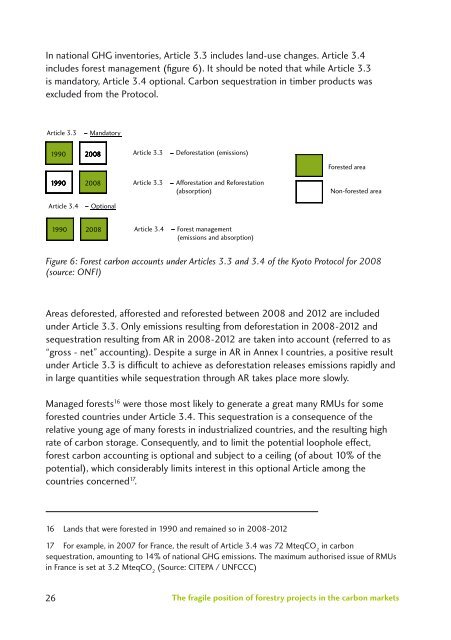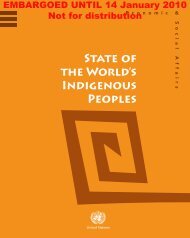Bringing forest carbon projects to the market
Bringing forest carbon projects to the market
Bringing forest carbon projects to the market
You also want an ePaper? Increase the reach of your titles
YUMPU automatically turns print PDFs into web optimized ePapers that Google loves.
In national GHG inven<strong>to</strong>ries, Article 3.3 includes land-use changes. Article 3.4includes <strong>forest</strong> management (figure 6). It should be noted that while Article 3.3is manda<strong>to</strong>ry, Article 3.4 optional. Carbon sequestration in timber products wasexcluded from <strong>the</strong> Pro<strong>to</strong>col.Article 3.3 –Manda<strong>to</strong>ry1990 20081990 2008 Article 3.3 –De<strong>forest</strong>ation (emissions) Article 3.3 –Af<strong>forest</strong>ation and Re<strong>forest</strong>ation(absorption)Forested areaNon-<strong>forest</strong>ed areaArticle 3.4 –Optional1990 2008 Article 3.4 –Forest management(emissions and absorption)Figure 6: Forest <strong>carbon</strong> accounts under Articles 3.3 and 3.4 of <strong>the</strong> Kyo<strong>to</strong> Pro<strong>to</strong>col for 2008(source: ONFI)Areas de<strong>forest</strong>ed, af<strong>forest</strong>ed and re<strong>forest</strong>ed between 2008 and 2012 are includedunder Article 3.3. Only emissions resulting from de<strong>forest</strong>ation in 2008-2012 andsequestration resulting from AR in 2008-2012 are taken in<strong>to</strong> account (referred <strong>to</strong> as“gross - net” accounting). Despite a surge in AR in Annex I countries, a positive resultunder Article 3.3 is difficult <strong>to</strong> achieve as de<strong>forest</strong>ation releases emissions rapidly andin large quantities while sequestration through AR takes place more slowly.Managed <strong>forest</strong>s 16 were those most likely <strong>to</strong> generate a great many RMUs for some<strong>forest</strong>ed countries under Article 3.4. This sequestration is a consequence of <strong>the</strong>relative young age of many <strong>forest</strong>s in industrialized countries, and <strong>the</strong> resulting highrate of <strong>carbon</strong> s<strong>to</strong>rage. Consequently, and <strong>to</strong> limit <strong>the</strong> potential loophole effect,<strong>forest</strong> <strong>carbon</strong> accounting is optional and subject <strong>to</strong> a ceiling (of about 10% of <strong>the</strong>potential), which considerably limits interest in this optional Article among <strong>the</strong>countries concerned 17 .16 Lands that were <strong>forest</strong>ed in 1990 and remained so in 2008-201217 For example, in 2007 for France, <strong>the</strong> result of Article 3.4 was 72 MteqCO 2in <strong>carbon</strong>sequestration, amounting <strong>to</strong> 14% of national GHG emissions. The maximum authorised issue of RMUsin France is set at 3.2 MteqCO 2(Source: CITEPA / UNFCCC)26The fragile position of <strong>forest</strong>ry <strong>projects</strong> in <strong>the</strong> <strong>carbon</strong> <strong>market</strong>s
















